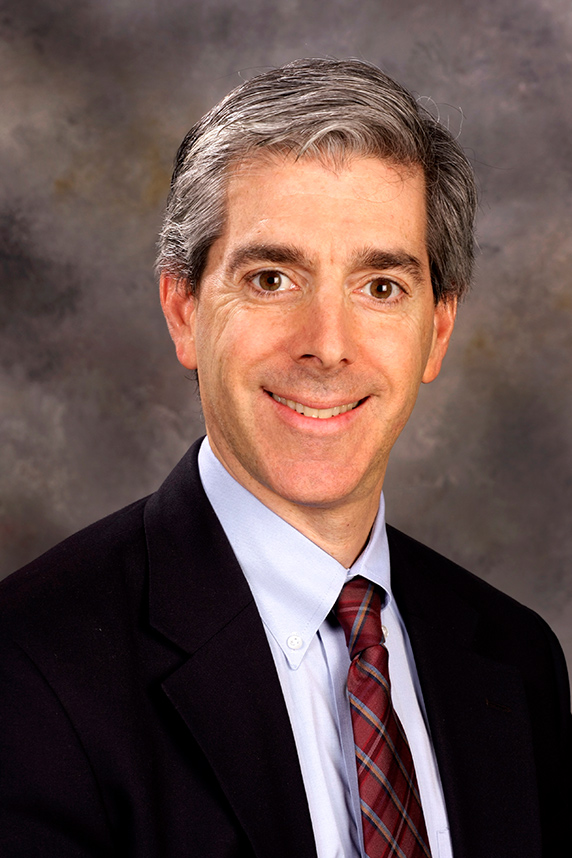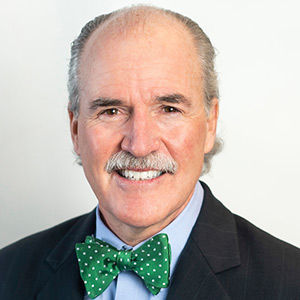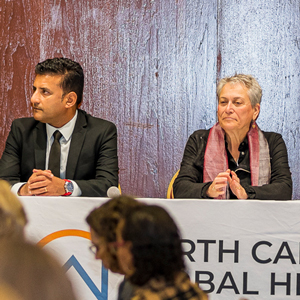 Balbus underscored the importance of helping people adapt to change and prevent illness, with an emphasis on environmental justice, social justice, and health inequities. (Photo courtesy of Steve McCaw)
Balbus underscored the importance of helping people adapt to change and prevent illness, with an emphasis on environmental justice, social justice, and health inequities. (Photo courtesy of Steve McCaw)On May 6, NIEHS Senior Advisor for Public Health John Balbus, M.D., kick-started a new seminar series on climate, environment, and health, which is sponsored by the Global Environmental Health (GEH) program. Balbus described the many ways in which a changing climate affects human health.
“The interaction of climate, health, and environment is a critically important topic for the senior leadership here at the NIEHS,” said NIEHS Acting Director Roy Woychik, Ph.D., in his introduction. Woychik noted that the 2018-2023 NIEHS Strategic Plan recognizes the effects of climate on health as an emerging environmental health issue for the institute to focus on.
“We are at a critical juncture in human history, with the opportunity to understand risk factors and vulnerabilities, and to seek solutions to lessen the effects,” Balbus said.
The seminar, “How Climate Changes Health and Why You Should Care,” drew more than 630 early registrations.
Climate cycles back into human health
Balbus showed a photograph of Earth taken from the International Space Station. “The green strip at the top of the picture is the troposphere — the 0.1% of Earth’s diameter that is the air that we breathe and that we share as inhabitants of the planet,” he said. “Changes we are creating are leading to some dramatic changes in our weather, in our ecosystems, and ultimately in health, and ask very important survivability questions.”
Since the First Industrial Revolution, Earth’s average temperature has increased 1 to 1.2 degrees Celsius. The oceans store some of this heat, affecting weather patterns and storm severity.
“This is an observation; it is not something that is modeled for the future with a lot of uncertainty,” Balbus said, sharing data on increased hurricane intensity during the past decade.
He warned that warming will continue beyond 2100, even with quick action now, due to heat already trapped in the oceans.
 The troposphere is the atmospheric layer closest to Earth’s surface. Five to nine miles thick, it is named for its constantly changing weather and mixture of gases — “tropos” means change in Latin. Photographed in October 2011 by crew of the International Space Station. (Photo courtesy of National Aeronautics and Space Administration)
The troposphere is the atmospheric layer closest to Earth’s surface. Five to nine miles thick, it is named for its constantly changing weather and mixture of gases — “tropos” means change in Latin. Photographed in October 2011 by crew of the International Space Station. (Photo courtesy of National Aeronautics and Space Administration)Increased prevalence of infectious diseases
Like other living beings, disease-causing microorganisms are affected by changing climate. For example, Dengue, chikungunya, and Zika are of growing concern in the U.S., due to the shifting habitat of Aedes mosquitoes.
“The picture with vector-borne diseases is complicated,” Balbus said. Factors such as human behaviors and land use also influence the spread of such diseases.
Lower food quality and productivity
Droughts and floods both lower crop productivity. These climate-related changes are accompanied by lower nutritional content of staple crops, Balbus said.
Higher carbon dioxide levels spur plant growth, he explained, altering plants’ nutrient uptake. Nutritional loss combines with lost productivity to worsen risk of malnutrition.
Human systems complicate effects
Human systems drive indirect impacts of a warming planet. Individuals with poor socioeconomic status are most vulnerable, Balbus stressed. Having fewer resources makes a person less resilient, with a higher risk of death or illness from adversities like hurricanes, melting permafrost, or floods.
Furthermore, communities may experience social disruptions and infrastructure damage, making residents more susceptible to post-traumatic stress disorder.
“We tend to not focus on mental health as much as other diseases and illness, but it is a very important part of health and climate change,” he said.
Not too late
Balbus struck a hopeful tone with the observation that we have both opportunity and tools to act. Such actions include transitioning from fossil fuels to renewable energy, walking and bicycling, improving building insulation, reducing use of biomass and other solid fuels for cooking, and eating plant-based and locally produced food.
Science-based preparedness and risk reduction will help lower costs. “We see clearly how costly it is to focus only on [crisis] responses when there are many things that can be done [beforehand],” Balbus said. “Health science is an extremely important voice in the debate about solutions [needed] to avert the worst of climate change.”
During the discussion time after seminar, Woychik asked how to do a better job communicating with those who believe the current changes are due to a normal climate cycle. Balbus replied that Earth’s temperatures are increasing, yet solar activity has decreased in the past 10 years, so solar cycles are not the cause. He urged scientists to recognize that data can be overwhelming and can cause anxiety and fear. Addressing these issues may aid communication efforts.
(Payel Sil, Ph.D., is a contractor in the NIEHS Biostatistics and Computational Biology Branch.)









